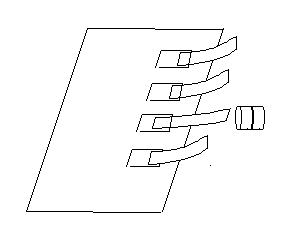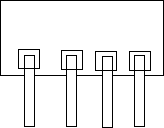
A piece of magnetic cassette tape is attracted by a magnet.
Make the world’s cheapest Digital Audio Tape recorder.
Introduction
Cassette tape can be magnetized, and then read with a small magnet. The magnetized tapes can be used to store digital information in the same way that a computer stores it. The tapes can also be used to model sea floor spreading.

Materials
Assembly

To Do and Notice
Find the north end of the magnet. Use a compass. The south end of the compass will point to the north end of the magnet. Mark the north end. Use a piece of tape, a dot of White-Out etc.
(You can also find the north end by taping the magnetic cylinder to 18 inches of string. Then hang the magnet, it will rotate until its north pole faces the geographic north pole.)
Stroke one of the tapes with the north pole of the magnet.
Start at the attached end and stroke toward the free end once. The magnetic field of the magnet is strong enough to magnetize the tape.
Bring the north end of the magnet back toward the magnetized tape slowly as shown in the first illustration. Notice that the magnet attracts the tape.
Flip the cylindrical magnet around and bring its south end toward the magnetized tape slowly. Notice that the magnet repels the tape.

Keep approaching the tape, when you get close enough, the magnet will suddenly attract the tape.
What’s going On?
The cassette tape is covered with a layer of magnetizable particles, commonly oxides of iron. These particles become magnetized when they are exposed to a strong magnetic field from a nearby magnet. They keep this magnetization until they are re-magnetized by another close approach by a magnet. The tape has a magnetic memory. Stroking the tape with the north end of the magnet magnetized the tape so that the free end of the tape becomes a south pole. The south pole of the tape is attracted by the north pole of the magnet, and repelled by a south pole.
The south pole suddenly attracts the tape &emdash; which it had been repelling&emdash; when the magnetic field of the magnet becomes strong enough to re-magnetize the tape, creating a north pole where a south pole had been.
So What?
Cassette recorders and digital, binary recording
In a cassette recorder an electromagnet magnetizes the tape. Sound is encoded as a pattern onto the magnetic particles of the tape. The tape can be “read” by passing it near a coil of wire. The changing magnetic field of the tape induces currents in the coil. The currents can be turned back into sound.
A digital recorder like this one creates patterns of north and south magnetization on the tape. Thus you can use your tape apparatus to record and send binary messages.
Magnetize the tapes of your card in the following pattern: NSNS then swap your card with your neighbor. Read your neighbors card. Be sure to approach the tapes slowly and to read the first motions, if you get too close you will erase your neighbors message.
After you are sure you can read the message, Write your own pattern and swap again.
We could call tapes that are attracted by a north pole 1 and tapes repelled 0. Then the four tapes would represent a 4 digit binary number, called a four bit binary number. NSNS becomes 0101 and SSNN, 1100. To assign one binary number to each letter of the alphabet you would need 5 bit numbers, to encode capital letters and symbols the ASCII code uses 8 bits. See the attached pages.
Magnetic recording by rocks and continental drift.
The tapes could also represent magnetizable rocks formed at the mid ocean rifts. These rocks are magnetized by the earth’s magnetic field when they cool from molten rocks to cold solid rocks. The earth’s magnetic field flips its direction from time to time (The last time it flipped was about 700,000 years ago.) Geophysical research ships sail over the mid ocean ridge and measure the magnetization of the rocks. They find alternating bands of north and south magnetized rock. You can model this process with your tapes.
Etc.
A digital cassette recorder will record at least 44,000, 16 bit binary numbers a second in order to accurately record music. Make a piece of cardboard with 16 tapes. How long does it take you to record one 16-bit binary word? To read it? Your recorder is considerably cheaper than the commercial digital cassette recorder.
The most common coating on magnetic recording tape is called gamma ferric oxide.
An 8 bit binary number is called a byte. A 4 bit number is called a nibble.
|
Scientific Explorations with Paul Doherty |
|
17 March 2002 |